














October 08, 2017 | permalink
As the leaves begin to turn, I’m finally taking a break from a frenetic summer and early fall of speaking. After wrapping up the spring with trips to Bangkok and Zurich (where I met the team behind the phenomenal Projket Interim) I’ve stuck closer to home – or at least to North America. A few highlights:
• Most recently, I was in Chicago for the Big Ideas Summit hosted by Procurious, a British social network for procurement professional (the people who run the world’s supply chains). My talk – the very short version of which is posted above – focused on “engineering serendipity,” and both unknown knowns and unknown unknowns. (I gave a similar talk earlier in the month to the Investment Industry Regulatory Organization of Canada in forest fire-choked British Columbia.)
• The week before that I was in Denver, then Victoria (British Columbia) speaking about the future of cities. In the case of the former, I was the opening keynote for this year’s RE/MAX Commercial Symposium, where I used Amazon’s HQ2 RFP as a prism to examine how cities and CRE prefernaces are changing. The next day in Victoria, I spoke at the inaugural Platform retreat hosted by the American Society of Interior Designers about how new mobility options, shared workspaces, and networks are transforming cities.
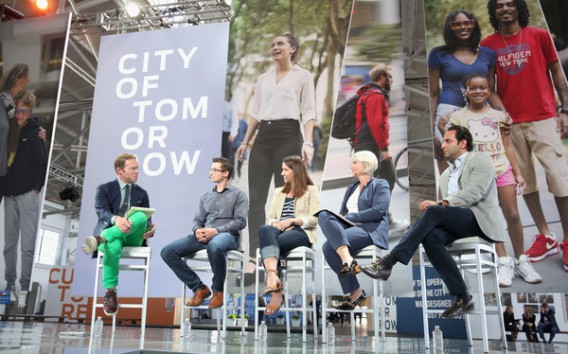
• In August, I moderated back-to-back events in San Francisco for Intel and Ford, both focused on the future of mobility. The former hosted an intimate press event to discuss its “Passenger Economy” report on the $7 trillion economic impact from autonomous vehicles by 2050, while Ford invited more than a thousand people to Fort Mason for its “City of Tomorrow Symposium.” As seen above, I was invited to moderate a panel on mobility-as-a-service, and how we go about actually building such a system. (Also on the mobility beat: in September I spoke the Columbus Partnership as part of their efforts to implement the Smart Columbus plan, which won the Department of Transportation’s Smart City Challenge.)
• But the highlight of the summer were back-to-back appearances in Colorado Springs and Albuquerque in late August. The first was for a brief talk to the senior leadership of Deloitte’s Technology, Media, and Telecommunications practice on how we might rethink the idea of what a “smart city” is. For example, rather than through solar panels and a Tesla Powerwall into your suburban home, what if we could convince institutional investors to build thousands upon thousands of Alejandro Aravena’s “half-built” homes in exchange for a 50-year on the solar electricity collected from their rooftops?
From there, I drove to Sandia National Laboratories in New Mexico for an unclassified, but off-the-record workshop on the world in 2035. I can’t divulge many details until the final report is published, but it was exhilarating to spend the day in the presence of so many brilliant people trying to invent the future. More soon, I hope.
• The rest of the fall is a bit quiet, with one great exception. Next month, I head to Los Angeles for the inaugural edition of LA CoMotion – a five-day festival of new mobility in the Arts District downtown. As director of strategy, my job is make sure the whole is greater than the sum of its many very cool parts. With only five weeks to go until Nov. 15-19, we’re in the home stretch. You can get a taste of what I’m thinking in the video below. See you on the other side.
October 06, 2017 | permalink
I was delighted to return to Christopher Lydon’s “Radio Open Source” on WBUR this week to discuss “Adapting to Disaster: The Future of Cities in the Anthropocene,” the second in a two-part series on climate change. (You can listen here.) I was joined by friends and colleagues Chris Turner – author of the The Geography of Hope and The Patch – and Rafi Segal, along with New York 2140 author Kim Stanley Robinson and Harvard’s Naomi Oreskes. Please give it a listen.
September 18, 2017 | permalink
When Hurricane Harvey swamped Houston this month, followed only days later by Irma’s bearing down on Florida my first thought was: They’ve arrived five years ahead of schedule. Because I’d spent the last six months imagining America’s day of climate change reckoning – a super storm destroying $200 billion worth of property (like Harvey) after landing a direct hit on New York City (as Irma nearly landed on Miami). I’d spent the last six months I’ve been working with an incredibly talented team of architects imagining how the coasts of New York and New Jersey might look after six feet of sea-level rise, and the triggering event I’d generously scheduled for 2022 was arriving only weeks after our work had been unveiled.
Some backstory: we were commissioned in February by the Regional Plan Association (with funding from the Rockefeller Foundation) to envision the Tri-State region underwater as part of 4C: Foreseeing the Region of the Future, a design competition launched ahead of the Fourth Regional Plan – the RPA’s once-in-a-generation planning guidelines.
I was invited by my Foreclosed teammate Rafi Segal to join him, DLANDstudio’s Susannah Drake, and MIT’s Sarah Williams, Brent Ryan, and Benjamin Albrecht as part of the core team creating The Bight: Coastal Urbanism. The Bight is the notch in the coast where ocean currents conspire to pile sand, forever redrawing the shore. Rather than simply harden the coastline against sea-level rise and future storms, we proposed “sending and receiving” residents in vulnerable areas to new developments on higher ground, while transforming New York’s future wetlands for new uses – whether parks or farms or preserves.
My role on the team was to imagine a backstory for the world we made, and how we got there – a future history encompassing the near-destruction of Lower Manhattan by Hurricane Hermine in October 2022; the resulting Crash of ’23 as real estate values plunged along the East Coast; the subsequent creation of the Bureau of Coastal Management to create ironclad zoning and development guidelines; the dissolution of the Port Authority by mutual agreement of Governors Cuomo and Bon Jovi; the election of President Mark Zuckerberg in 2024, who soon instituted universal basic income (“Zuckerbucks”) and housing (“Zuckerhuts”), while pushing a clean energy agenda that led to the merger of ExxonMonsanto.
To bring this world to life, my teammates and I not only designed a new city around Jamaica Bay and new communities along the coasts of New Jersey and Long Island, but also imagined their future residents – including a video postcard from an ExxonMonsanto artisanal seaweed harvester and a promotional video (see above) for the 25th anniversary of Ascendas-Singbridge Bight City, starring a 2067 incarnation of our teammate Chaewon Ahn.
Our work was displayed this summer at Fort Tilden in the Rockaways, and will be exhibited in Manhattan sometime this winter at the New York Historical Society.
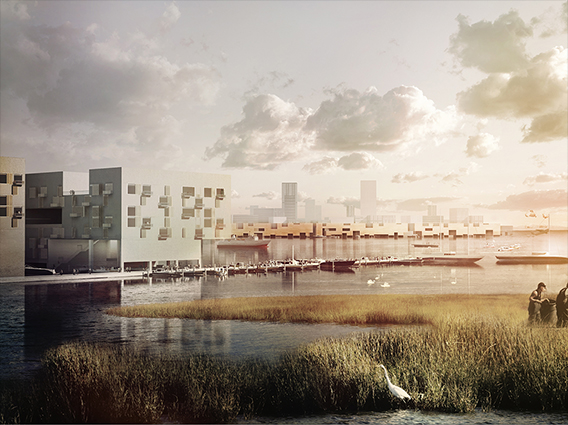
July 29, 2017 | permalink

I love to tell the story of how when I first visited New Songdo City in 2007, the site of the future Central Park (pictured above) was nothing more than mud studded with seashells, having only recently been dredged off the seafloor. Today, as you can see, the park has come into its own, even if the city – now with 100,000 inhabitants – still feels patchy at times. In this short clip directed by Ghost Cities of China author Wade Shepherd and shot in June at the New Cities Summit, I talk about how Songdo succeeded almost in spite of itself, and how we project our own hopes and fears for the future onto these instant cities.
July 20, 2017 | permalink
In June, I paid a visit to the instant city of New Songdo for a the first time in nearly decade as part of the annual NewCities Summit, my sixth(!). If you couldn’t make it, videos of each session have just been posted, of which I moderated a pair this year.
The first (above) focused on “Global Connectivity and the Success of Cities,” starring AirAsia CEO Tony Fernandes (whose Berluti sneaker game was strong), ENGIE’s Olivier Biancarelli, Aéroports de Paris’s Elisabeth Le Masson, and Kandahar mayor Roshaan Wolusmal. As you might expect, our conversation focused on infrastructure. From the session description: “Second, third and fourth-tiered cities will absorb most of the new urban population, and will therefore hold a great role in their national economies. How can we increase their connectivity to other levels of economy? What challenges do these cities face in accessing global markets? What is the impact of greater connectivity on a city’s planning, infrastructure, economy, and attractivity?”
The second (below), told “the Story of Songdo,” with Gale International’s Tom Murcott, Arup’s Ashok Raiji, KPF’s Elie Gamburg, and former Cisco chief globalization officer Wim Elfrink. Between recapping the project and efforts to subsequent efforts to create cities from scratch that are faster, better, cheaper, perhaps the most notable admission was Elfrink’s candid admission that Cisco’s attempt to build a hardwired smart city had failed – it had been overtaken by the same technologies it had hoped to exploit.
July 17, 2017 | permalink
Last month, I was invited to Bangkok by Seedstars and Thailand’s Ananda Development to speak about “Cities-as-a-Service,” host a panel with my friends and colleagues Ayesha Khanna (ADDO AI), Anthony Vanky (MIT Senseable Cities), and Yaron Schwarcz (Tridom), and host a workshop envisioning potential future of urban tech.
A brief video excerpt from my talk is above. Thanks again to both Seedstars and Ananda for hosting me!
July 14, 2017 | permalink
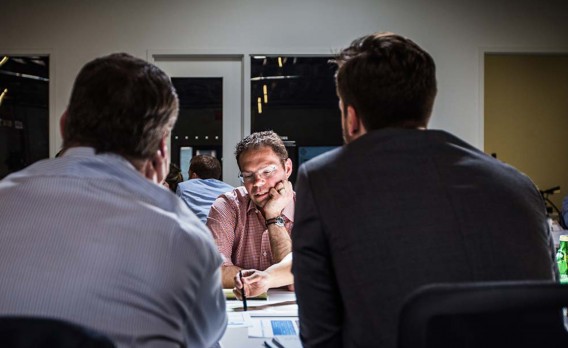
Back in May, I was invited to join dozens of architects, mobility experts, public officials, startups, and others for a autonomous and connected vehicle design sprint organized by the engineering firm BuroHappold. Our team was tasked with redesigning Manhattan’s Columbus Circle – my teammate Derrick Choi explains our plan below.
Derrick Choi (Populous), Greg Lindsay (Fast Company), Mike Seyle (BuroHappold), Nicola Thomson (100 Resilient Cities), Patrick Smith (NYC Department of Transportation)
Write-up by Derrick Choi
What is your team’s idea?
Columbus Circle is an icon that can never be truly occupied. Traffic roundabout, NYC landmark, and post card icon – right adjacent to Central
Park, but never a part of it. In the dawn of connected and autonomous vehicular networks, the time to reimagine the Circle is now. Imagine finally being able to occupy Columbus Circle AND enhance traffic flow? Our concept seeks to do just that by physically integrating Columbus Circle with Central Park to enhance the pedestrian experience, improve the flow of transit, and introduce a new proving grounds for CAVs and delivery vehicles south of Columbus Circle along Broadway.
There are some fundamental planning assumptions behind the concept:
1. Re-routing traffic flow will enhance traffic while improving open space.
2. The improvements seek to balance – to the extent practicable – the interests and operational requirements of pedestrians, bicyclists, public transit, personal vehicles, CAVs as well as public-private development opportunities.
3. Public policy shall be innovation-friendly and will encourage testing extant infrastructure to adapt to new technologies and solutions.
4. Connected and autonomous vehicle networks will be an integral component of the City’s transportation system.
5. Public private partnerships are encouraged to advance innovative infrastructure and urban ideas.
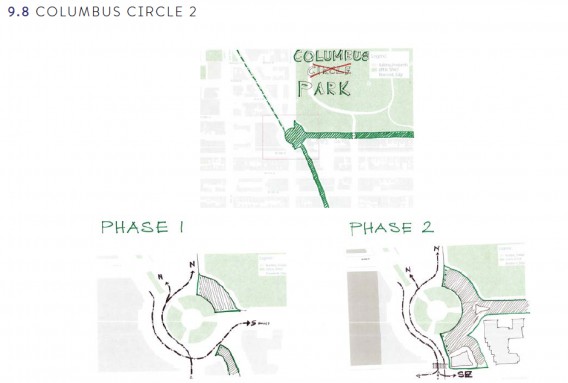
We offer a multi-phase approach to stitching Columbus Circle into Central Park. The multi-stage strategy gives the City the flexibility to test concepts with little risk:
PHASE 1 – Absorb the Roundabout
• Shut off quadrant facing Central Park with retractable bollards and paint the street; creating a contiguous public space extension; stitching Columbus Circle to Central Park.
• Re-route traffic flow in a north-south configuration: Broadway (north of 58th) to Central Park South provides a south flow while Broadway (south of 58th) to Central Park West provides a north flow. NOTE: South-bound traffic flow is diverted to Central Park South.
• Broadway South of 58th Street will be cut off of traffic on a regular basis as a test corridor for CAV technologies – especially for off-hour test runs of delivery robots originating from the Columbus Circle Whole Foods – running down all the way to Union Square.
PHASE 2 – Absorb the Streets
• Shut off all of Central Park South and the entire roundabout from Broadway to the start of Central Park West from vehicular traffic; effectively repurposing about HALF of the Columbus Circle roundabout into public open space.
• Re-route traffic flow permanently in the following manner:
• South flow: Broadway to 8th Avenue
• North flow: 8th Avenue to Central Park West
• East / West flow: turn at 57th and 8th Avenue
• Dedicated South Broadway route (south of 57th Street) for CAV and pedestrian-centric activities.
While the Circle goes away – almost half of it becomes absorbed by Central Park – the operational and quality of life improvements are considerable. At the new Columbus Park, traffic improves, Broadway and Central Park South becomes dedicated for open public space and a new north-south axis for traffic is provided.
Why is this a good idea for your city?
Columbus Circle’s riddle is solved once and for all when traffic improves and the quality of public life can be improved at the site. We believe there are 4 primary benefits worth thinking about:
1. Introduction of dynamic new public spaces – Central Park South becomes a dedicated pedestrian-only public corridor and Columbus Circle becomes a truly public space with no traffic disruption.
2. Commitment to a new dedicated Broadway technology corridor from the Circle to Union Square – providing a new test bed for CAVs while
recommitting to the public realm.
3. Significant traffic and environmental enhancements – re-alignment of the North-South flows will eliminate congestion, idling, and overall air quality for the immediate area.
4. Encouragement of strong public-private collaboration – from delivery robots from Whole Foods to new private sector sponsorships of new public corridors, new opportunities to reclaim the streets will deliver incredible dividends for the City.
What would need to happen to implement your team’s idea?
No idea can be implemented in a vacuum. The successful implementation of the Columbus Circle concept will weigh heavily on the ability of the City to be able to test these ideas in such a heavily trafficked location that must last the test of both pedestrians as well as vehicles.
There will likely be a combination of aggressive, phased testing and recalibration of the test corridors as well as strong policies advocating for innovation and public-private partnerships. Implementation will require a two-fold collaboration between public agencies who must test the corridors and implement the policies and the private sector players who need to understand the needs of their stakeholders.
June 30, 2017 | permalink
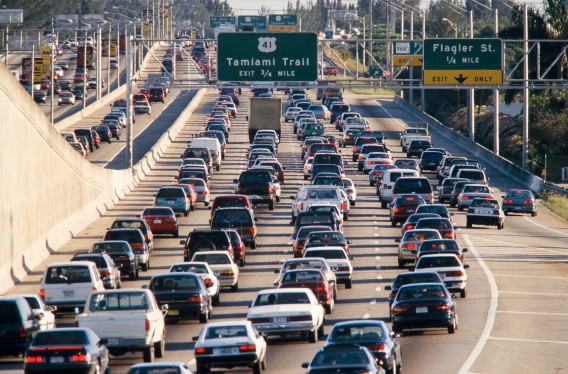
(Originally published by Politico Magazine as part of its July/August 2017 Cities issue. Proud to be included alongside Columbia’s Saskia Sassen, Charlotte mayor Pat McCrory, Brookings’ Bruce Katz, former Memphis mayor A.C. Wharton, Retrofitting Suburbia authors June Williamson and Ellen Dunhanm-Jones, and many more. You can read the entire thing here.)
Since the financial crisis, America’s largest metros have been reliable job and people magnets, breathing new life into exurban sprawl with new residents who “drive until they qualify” for an affordable mortgage on a home outside a city. But these suburbanites and exurbanites are left exposed to the high costs of commuting in terms of both time and money, as well as to the devastating effects of another potential oil shock like the 2008 price spike that precipitated the crisis. At the same time, gentrification has transformed America’s densest, most walkable and transit-rich neighborhoods into some of the country’s most expensive, thereby expelling their former inhabitants to the suburban fringe. This has turned out to be a trap: Nearly half of affordable-housing residents spend more than 15 percent of their incomes on transportation. Public transit alone is of little help, as researchers at Brookings have found that a typical resident is able to reach only 30 percent of a city’s available jobs in less than 90 minutes using transit. In turn, long, expensive commutes depress growth and punish their most vulnerable residents.
The proposed solutions to these problems tend to veer quickly toward the fantastical–cars that fly or drive themselves, or one of Elon Musk’s new tunnels. Others tout Uber as a fix that will render buses obsolete. The truth is that Uber and its competitors have only added to congestion in cities such as New York and San Francisco, and autonomous vehicles could make the problem worse in the form of driverless traffic jams. Meanwhile, New subway systems from New York to Washington groan under the strain of new riders and deferred maintenance.
An alternative solution would be to combine public transit with these new technologies on the same app or platform, using the convenience of car-sharing, bike-sharing and ride-hailing to increase ridership and promote alternatives to car ownership. “Mobility-as-a-service” programs combining various modes have been successfully tested in Europe, but haven’t yet made it to the United States. Coupling better transit service with on-demand rides for last-mile and last-minute solutions could prove incredibly appealing to commuters, and combining it with smarter regulations for parking, zoning and congestion could make them even more so. While President Donald Trump continues to tout a public-private $1 trillion infrastructure package that is actively hostile to rail projects, Los Angeles residents, for instance, voted overwhelmingly in November to tax themselves $100 billion over 30 years for transportation projects, including five new rail lines. Cities such as Seattle and Atlanta have followed suit with similar measures, with the former promising to invest in what it calls “new mobility.” Cities thrive by comfortably compressing large number of people together in space and time. We need to invest intelligently in methods both old and new to ensure they can keep growing.
June 26, 2017 | permalink
(I’m currently the Urbanist-in-Residence for URBAN-X, the startup accelerator backed by Urban US and BMW MINI. Fast Company asked me to host this video starring three of the teams in the accelerator’s second cohort: WearWorks; Contextere; and UpCycles. Enjoy!)
June 10, 2017 | permalink

Last week. Intel published a report on what it’s calling the “Passenger Economy” – the $7 trillion created by 2050 once the time, money, energy, and attention devoted to driving is channeled elsewhere in a world of autonomous vehicles. Working with Intel and the research firm Strategy Analytics, I was asked to imagine how this new economy larger than the UK’s and Germany’s combined today will begin to appear, and how it will reshape where and how we live, work and play. Ranging from “mobility-as-a-service” to aerial drone delivery to self-driving homes (as AVs mate with RVs), the autonomous future will transform cities – hopefully for the better.
The launch of the report (featuring my quotes) has been covered by Wired, The Telegraph, The Detroit News, CNBC, CNET, and Venture Beat, among many others. There’s also been significant international coverage in Singapore, Hong Kong, Germany, France, Italy, Spain, and Australia, to name just a few. Going forward, I’ll be writing and speaking about the report at Intel events in New York, Detroit, Washington and beyond. Stay tuned!

» Folllow me on Twitter.
» Email me.
» See upcoming events.

Greg Lindsay is a generalist, urbanist, futurist, and speaker. He is a non-resident senior fellow of the Arizona State University Threatcasting Lab, a non-resident senior fellow of MIT’s Future Urban Collectives Lab, and a non-resident senior fellow of the Atlantic Council’s Scowcroft Strategy Initiative. He was the founding chief communications officer of Climate Alpha and remains a senior advisor. Previously, he was an urban tech fellow at Cornell Tech’s Jacobs Institute, where he explored the implications of AI and augmented reality at urban scale.

----- | January 22, 2024
The Future of Generative AI in Architecture, Engineering, and Construction
----- | January 1, 2024
----- | August 3, 2023
CityLab | June 12, 2023
Augmented Reality Is Coming for Cities
CityLab | April 25, 2023
The Line Is Blurring Between Remote Workers and Tourists
CityLab | December 7, 2021
The Dark Side of 15-Minute Grocery Delivery
Fast Company | June 2021
Why the Great Lakes need to be the center of our climate strategy
Fast Company | March 2020
How to design a smart city that’s built on empowerment–not corporate surveillance
URBAN-X | December 2019
CityLab | December 10, 2018
The State of Play: Connected Mobility in San Francisco, Boston, and Detroit
Harvard Business Review | September 24, 2018
Why Companies Are Creating Their Own Coworking Spaces
CityLab | July 2018
The State of Play: Connected Mobility + U.S. Cities
Medium | May 1, 2017
Fast Company | January 19, 2017
The Collaboration Software That’s Rejuvenating The Young Global Leaders Of Davos
The Guardian | January 13, 2017
What If Uber Kills Public Transport Instead of Cars
Backchannel | January 4, 2017
The Office of the Future Is… an Office
New Cities Foundation | October 2016
Now Arriving: A Connected Mobility Roadmap for Public Transport
Inc. | October 2016
Why Every Business Should Start in a Co-Working Space
Popular Mechanics | May 11, 2016
Can the World’s Worst Traffic Problem Be Solved?
The New Republic | January/February 2016

January 31, 2024
Unfrozen: Domo Arigatou, “Mike 2.0”
January 22, 2024
The Future of Generative AI in Architecture, Engineering, and Construction
January 18, 2024
The Promise and Perils of the Augmented City
January 13, 2024